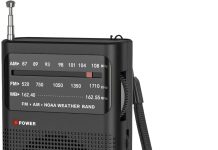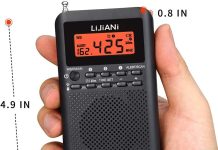Emergency radios are invaluable tools during times of crisis, but have you ever wondered if they need software or firmware updates? In this article, we will explore whether emergency radios require these updates and why they are important. Whether you rely on an emergency radio for safety or are simply curious about the technology behind these devices, read on to discover the answer.
Review contents
Introduction
Emergency radios play a crucial role in disaster situations by providing communication channels and critical information to those affected. But have you ever wondered if these lifesaving devices themselves require updates? In this article, we will delve into the world of emergency radios and explore the importance of software and firmware updates for these essential gadgets. We will also discuss the benefits of regular updates, the challenges they may present, and how manufacturers and industry standards influence the frequency of updates. So, let’s embark on this informative journey and uncover the mysteries behind emergency radio updates.
Understanding Emergency Radios
Definition and Purpose of Emergency Radios
Emergency radios, also known as weather radios or disaster radios, are specially designed devices that receive and transmit radio signals to provide up-to-date information during emergency situations. These radios are essential for individuals and communities to stay informed about weather forecasts, evacuation notices, emergency alerts, and other critical information when traditional communication methods may be disrupted.
Types of Emergency Radios
There are various types of emergency radios available, catering to different needs and scenarios. The two primary categories include handheld radios and desktop radios. Handheld radios are portable, battery-operated devices that allow users to carry them anywhere and receive real-time updates. On the other hand, desktop radios are larger, more powerful devices that typically require a power source and may include additional features such as AM/FM radio and NOAA weather radio.
Importance of Emergency Radios in Disaster Situations
During emergencies, communication is essential for both response teams and affected individuals. Emergency radios provide a reliable means of receiving crucial information from authorized sources like national weather services, emergency management agencies, and local authorities. They bridge the communication gap, ensuring that vital notifications, warnings, and instructions reach those in need. By staying informed through emergency radios, individuals can make informed decisions, prioritize safety measures, and coordinate effectively with other stakeholders.
Software vs Firmware
Difference between Software and Firmware
To understand the need for updates, it is essential to distinguish between software and firmware. Software refers to the programs or applications that run on a device, providing specific functionalities and features. On the other hand, firmware is a special type of software that is embedded within the hardware of a device, controlling its operation and facilitating communication between hardware and software components.
Importance of Software and Firmware in Electronic Devices
Both software and firmware are vital for the proper functioning of electronic devices, including emergency radios. Software allows manufacturers to introduce new features, improve user interfaces, and fix bugs or vulnerabilities. Firmware, being the underlying system that governs the hardware, ensures proper communication and compatibility between different components. Updates to software and firmware can significantly enhance the performance, functionality, security, and compatibility of electronic devices.
Usage of Software and Firmware in Emergency Radios
Emergency radios rely on both software and firmware to provide valuable information during critical situations. The software component of these radios enables users to navigate different functionalities, such as selecting specific weather bands, adjusting volume levels, or activating alerts. Firmware, on the other hand, controls the core functionalities of the radio, ensuring proper reception, decoding of signals, and interface responsiveness. Updates to both software and firmware are essential to address any issues, improve performance, and introduce new features that enhance the overall user experience and reliability of emergency radios.
Why Emergency Radios may Need Updates
Advancements in Technology and Features
As technology continues to evolve, emergency radios need to keep up with the latest advancements to meet the changing demands of users. Updates provide an opportunity to incorporate newer technologies, such as improved antenna designs, enhanced signal processing algorithms, or innovative communication protocols. By embracing these advancements, emergency radios can deliver better performance, extended coverage, and more accurate information, thus increasing their overall effectiveness during emergencies.
Bug Fixes and Security Vulnerabilities
No electronic device is free from bugs or potential security vulnerabilities, and emergency radios are no exception. Updates play a critical role in identifying and fixing these issues to ensure the reliable and secure operation of the radios. By addressing software glitches, improving error handling mechanisms, and patching security vulnerabilities, updates help maintain the integrity of emergency radio systems. This, in turn, ensures that the information received and transmitted during emergencies is accurate, trustworthy, and protected from potential threats.
Legal and Regulatory Requirements
Emergency radios are subject to various legal and regulatory standards to ensure their reliability and compatibility with other communication systems. Updates may be necessary to comply with changing regulations, standards, or protocols. For example, a regulatory authority may mandate the inclusion of specific alerting capabilities or require radios to support updated encryption algorithms to enhance the security of communications. Updates enable manufacturers to meet these requirements efficiently and ensure that emergency radios remain compliant with relevant regulations.
How Software and Firmware Updates Work
Updating Software on Emergency Radios
Updating the software of an emergency radio typically involves installing a new version of the software application that brings enhancements, bug fixes, or additional features. Manufacturers may release updates through various means, such as downloadable files from their websites or over-the-air (OTA) updates delivered wirelessly through the radio’s built-in connectivity options. Users usually follow step-by-step instructions provided by the manufacturer to initiate and complete the software update process, which may require connecting the radio to a computer or accessing a specific update menu on the device itself.
Updating Firmware on Emergency Radios
Updating the firmware of an emergency radio is a slightly different process compared to software updates. Since firmware resides on the hardware itself, the update process is often tightly integrated with the radio’s internal mechanisms. Manufacturers may distribute firmware updates in a similar manner to software updates, but the installation process requires special tools or utilities to access the firmware directly. Firmware updates may involve temporarily disconnecting the radio from power, entering a specific firmware update mode, or using specialized firmware update cables or adapters. It is crucial to carefully follow the manufacturer’s instructions and ensure that the firmware update is compatible with the radio model to prevent any potential issues.
Potential Challenges and Risks of Updates
While updates are crucial for ensuring the continuous improvement and reliability of emergency radios, they may also present certain challenges and risks. Incompatibilities between the updated software or firmware and the hardware or existing software on the radio can lead to malfunctions or system failures. Additionally, interrupted or unsuccessful update processes can render the radio inoperable. Therefore, it is essential to carefully follow the manufacturer’s instructions, ensure compatibility, and back up any critical data on the radio before initiating an update to mitigate the potential risks involved.
Benefits of Regular Updates
Improved Performance and Functionality
Regular updates to emergency radios can significantly enhance their performance and functionality. Manufacturers often introduce optimizations and refinements through software and firmware updates, resulting in improved signal reception, faster response times, and better overall user experience. Updates may also add new features, such as extended weather alert capabilities, customizable interfaces, or integration with emerging technologies like GPS. By keeping emergency radios up to date, users can benefit from the latest advancements, ensuring their radios are as efficient and effective as possible during emergencies.
Enhanced Compatibility and Interoperability
Updates play a vital role in ensuring the compatibility and interoperability of emergency radios with other communication systems and networks. As technology evolves, new standards, protocols, or encryption algorithms may emerge. By updating the software and firmware of emergency radios, manufacturers can ensure that the radios remain compatible with the latest communication technologies and can seamlessly integrate with other emergency response systems. This compatibility fosters effective coordination between different stakeholders, enabling efficient communication and response during critical situations.
Better Security and Resilience
Security is paramount when it comes to emergency communication systems. Regular updates help address potential security vulnerabilities and strengthen the resilience of emergency radios. Manufacturers actively monitor and respond to emerging threats, releasing updates that include security patches and enhancements. By promptly applying these updates, users ensure that their radios are protected against potential attacks, data breaches, or unauthorized access. Regularly updated emergency radios contribute to a more secure and trustworthy emergency communication infrastructure, providing peace of mind to both users and authorities.
Frequency of Updates
Factors Influencing Update Frequency
The frequency of updates for emergency radios can vary depending on several factors. One crucial factor is the rate of technological advancements in the field. If new technologies or features are being rapidly integrated into emergency radios, manufacturers may release updates more frequently to keep pace with these advancements. Another factor is the identification of bugs, vulnerabilities, or performance concerns. If users or manufacturers identify critical issues that impact the functioning or security of the radios, updates may be released urgently to address these concerns.
Manufacturer’s Policy on Updates
The frequency and availability of updates are often determined by the manufacturer’s policy. Some manufacturers may adopt a proactive approach, regularly releasing updates to improve their products and enhance user experience. Others may have a more reactive approach, only providing updates in response to specific issues or regulatory requirements. Checking the manufacturer’s website or contacting their customer support can provide valuable information regarding their update policies, including their commitment to regular updates and the availability of support for older radio models.
Industry Standards for Update Frequency
Industry standards and best practices also play a role in determining the expected frequency of updates for emergency radios. Various organizations and standardization bodies, such as the Federal Communications Commission (FCC), the International Electrotechnical Commission (IEC), or the National Institute of Standards and Technology (NIST), may establish guidelines or recommendations regarding product updates. Manufacturers often align their practices with these industry standards to ensure compliance and maintain the trust of users and regulatory agencies.
Updating Emergency Radios in Practice
Methods for Updating Software and Firmware
Updating emergency radios can be accomplished using different methods, depending on the radio model and the update mechanism provided by the manufacturer. One common method is to connect the radio to a computer with a USB cable and use specialized software provided by the manufacturer to initiate the update process. This method allows for a direct, controlled update that ensures compatibility and minimizes risks. Another method involves over-the-air (OTA) updates, where the radio’s built-in connectivity options, such as Wi-Fi or cellular data, allow for direct updates from the manufacturer’s servers. OTA updates are convenient but may require a stable internet connection and careful bandwidth management to ensure successful updates.
Ensuring Safe and Successful Updates
To ensure safe and successful updates, it is crucial to follow a few key practices. Firstly, it is essential to read and understand the manufacturer’s instructions and any associated documentation regarding the update process. This includes checking compatibility requirements, identifying potential risks, and backing up any critical data stored on the radio. Secondly, ensure that the radio is adequately charged or connected to a reliable power source during the update to prevent interruptions. Lastly, refrain from interrupting the update process once initiated, as doing so may result in a malfunctioning radio. Following these practices will increase the likelihood of safe and successful updates, ensuring that emergency radios remain in optimal condition.
Training and Education for Emergency Radios’ Users
As updates become a routine part of maintaining emergency radios, training and education play a crucial role in ensuring users can navigate the update process confidently. Manufacturers should provide user-friendly guides, video tutorials, or even interactive online courses that explain the update process step by step. These resources should cover aspects such as accessing update menus, connecting the radio to a computer, or initiating OTA updates. By empowering users with the knowledge and skills required for updates, manufacturers contribute to a more resilient emergency communication infrastructure and facilitate a seamless user experience.
Challenges and Limitations
Compatibility Issues with Older Models
One of the challenges faced when updating emergency radios is compatibility with older models. As technology progresses, older radios may not have the necessary hardware capabilities or memory to accommodate updates designed for newer models. This can result in a fragmented user base, with some individuals unable to benefit from the latest features or security enhancements. Manufacturers must strike a balance between supporting older models and pushing the boundaries of technology to ensure updates remain inclusive and accessible to as many users as possible.
Limited Connectivity in Remote Areas
In remote areas or during catastrophic events, traditional communication networks may be disrupted, making it challenging to access updates for emergency radios. Limited internet connectivity or power outages may hinder users’ ability to download or apply updates, leaving them with outdated software or firmware. In such cases, manufacturers and authorities must develop alternative strategies, such as providing offline update solutions or delivering updates through local distribution centers, to ensure that all users, regardless of their geographical location, can access essential updates for their emergency radios.
Resource Constraints and Budgetary Considerations
Updating emergency radios requires adequate resources, including financial investments, skilled personnel, and infrastructure support. Manufacturers must allocate resources to develop software and firmware updates, conduct thorough testing, and provide ongoing support to users. However, limited budgets or resource constraints may affect the frequency or availability of updates, particularly for lower-cost emergency radio models. Balancing the need for regular updates with budgetary considerations is a challenging task that manufacturers must navigate to maintain the quality and effectiveness of their emergency radios.
Conclusion
Emergency radios are indispensable tools in disaster situations, providing vital communication channels and crucial information to those affected. Software and firmware updates are essential for keeping these devices reliable, secure, and up to date with evolving technology and regulatory requirements. Regular updates improve performance, enhance compatibility, and bolster security, ensuring that emergency radios can effectively serve their purpose when it matters most. While challenges such as compatibility issues or limited connectivity may exist, manufacturers must strive to provide accessible and inclusive update mechanisms. By educating users, supporting older models, and adopting industry best practices, manufacturers can help build a resilient emergency communication infrastructure that empowers individuals and communities during times of crisis. So, remember to stay updated, stay informed, and stay prepared with your emergency radio by your side.




























